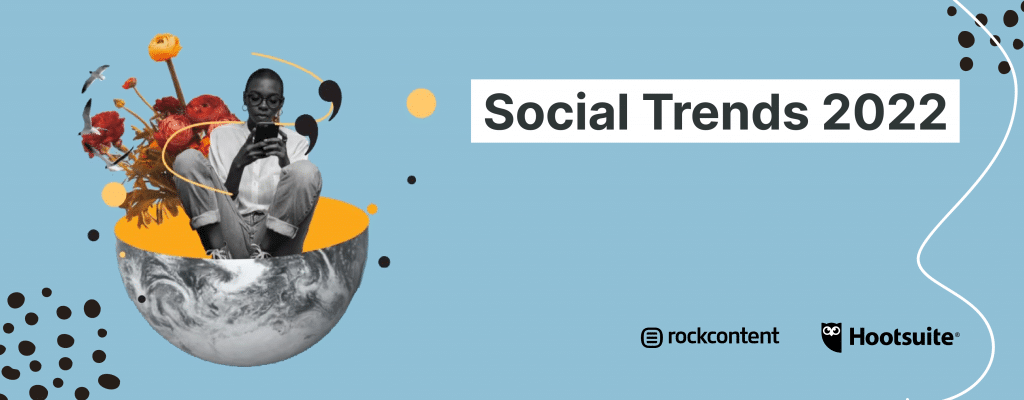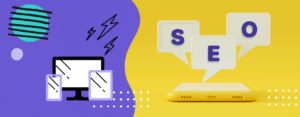Download this post by entering your email below
One of the challenges faced by businesses aiming to improve their user experiences is to figure out where to start.
Hootsuite’s largest annual campaign is the perfect example of how the process of improvement can – and should – work.
For the last seven years, much of its staff and stakeholders have spent a significant part of their time working to create Social Media Trends, a massive report describing the current state of online interactions and activity on social media.
Each year’s efforts require roughly eight months of research, from the first “let’s do this” meeting to the final “look at what we did” celebration. Researchers typically interview tech leaders and include opinions and data from thousands of users around the world.
The result is a comprehensive ebook that’s recognized as the state of the art by the social media community. It’s generally considered to be easy to read as well as visually stunning. It must be downloaded, an action that Hootsuite’s marketers use to track who is interested and perhaps invite them to engage with other company content.
So, how can this labor of love – but still a labor — be improved? Rock Content helped Hootsuite find a way.
This Thursday, I co-presented at Content Marketing Institute’s Demand Generation Summit session with Lisa Vecchio, Hootsuite’s Director of Global Campaigns. We shared with the event audience the brand new approach taken for the annual Social Media Trends 2022.
We discussed how Rock Content’s Ion platform brought a brand new experience to the readers of this year’s report. Taking advantage of the new interactive format, the user could navigate through the featured trends like ROI, social commerce, and customer experience, with videos, case studies and quizzes that invited them to interact with the content.
The experience also includes an ungated ebook that users can download, but Hootsuite invested in creating more in-depth and gated content like webinars, info sheets and playbooks, bringing tips on how marketers can succeed in each one of the trends the report featured. That’s where Hootsuite gained its downloads (and qualified leads!). The experience was a balanced mix of un-gated and gated content.
You might ask: “If I explain each trend and make ungated content available, I won’t generate any leads”. Hootsuite’s experience demonstrated that this is a clear marketing myth.
The shift to an interactive experience ultimately led to higher engagement, as information was easier for consumers to access, including most of the information being available online, rather than through a massive file download.
Talking about general numbers: unique traffic visiting these pages increased 34% as well as time on that page (up 119%), while the number of downloads grew by more than 30%.
I’ll go deeper to explain the strategy behind it.
Un-gate your content
Hootsuite began its efforts with the Social Media Trends report seven years ago, when marketing tech and customer behavior were slightly different than today.
Consumer preferences are always shifting, as are the tools that measure how well marketers are able to reach clients and encourage them to take action.
When the Social Media Trends report was launched for the first time, the average Hootsuite user may have had more time to consume content, and more importantly, more patience.
But with the proliferation of online content customers have evolved and expect more. Any obstacle or unexpected user experience difficulty, like poor user interfaces or bad content can drive people to move on to other content or product options.
Much of the online advertising in the past worked by interrupting consumers and getting their attention with something bright and shiny. Today that type of experience isn’t accepted anymore and being interrupted by a brand can cause a negative experience and sentiment. The point is not that we should stop digital advertising; but we need to change the approach, conveying emotions and adding personalisation
According to Millward Brown, 82% of the people skip ads as much as possible, and 27% use ad blockers to not see ads on desktop and mobile, an eMarketer study shows.
Dealing with unwanted content experiences can go beyond abandoning a shopping cart or closing a survey midway through. It can trigger extreme behaviors, such as canceling a subscription or posting a negative comment on social media.
Since clients expect good content experiences, businesses must adapt to the consumers’ changing behavior. It means that marketers need to focus on designing better experiences, and making sure each piece of content is a meaningful part of the whole experience.
Content experiences are made of several pieces of content spanning across all stages of the buyer journey, with the goal of driving customers toward activation. Each piece of content can be consumed individually or as a single element of a more complex journey. For this reason the full content experience is greater than its individual components.
As marketers, we can un-gate the content and make their access as easy as possible for the public. This goes against what’s considered a common practice in digital Marketing: requesting consumer information on every page or requiring registration before allowing people to access certain content, even the free one.
But, as demonstrated by Hootsuite’s case, when you un-gate and make use of content experiences across the full journey, people will engage more and will provide the first-party information that you need to achieve your Marketing goals.
From Lead Gen to Demand Gen
Lisa shared five lessons learned from the campaign:
1. Acknowledge that there’s a problem with the formula
The old ways of content consumption are dead. Importantly, inserting a form at every opportunity creates friction and a poor user experience. Over the years, as information became more readily available online, Hootsuite also recognized that every competitor started to produce a similar report.
It’s no surprise that B2B lead magnets are dying a slow death; the team at Hootsuite started to question why making something so difficult to obtain when people can get the answers for free, without having to give away their soul to access it. That’s how the team started to consider how they could truly differentiate.
2. Embrace the shift from lead generation to demand generation
The industry is making a huge shift at the moment from what is traditionally known as lead gen (basically lead or MQL capture) to demand gen (driving awareness and interest throughout the entire buyer and customer lifecycle all the way through to closed/won).
It means that in order to drive demand we need to think holistically about our user experience end to end.
3. Invest in the value exchange
If Hootsuite really wanted to differentiate themselves, they needed to provide value beyond just sharing the trends. So, in order to do this, their strategy included the “How”, not just the “What” in the value exchange.
The “What” is the heart of their engagement strategy. Each year Hootsuite identifies the top 5 trends marketers can expect for the year ahead, and there are many ways they can turn each trend into a content engine – for example blogs, videos, and case studies for each trend. As I said in the webinar, these pieces of content can be consumed individually or as a collective to compliment the inclusive experience.
And so when it came to the “How” of the value exchange, this was where Hootsuite knew they could capture people’s true interest. In other words, they asked the question: how can Hootsuite help? So they made more in-depth and hands-on content available to download, such as infosheets, playbooks, webinars and the full report and data set as a takeaway to share internally.
This is where they actually do the lead capture. After the reader already consumed the report, not before they even had a chance to digest anything.
4. Sweat the content
The principle of integrated marketing lies at the heart of the Social Media Trends 2022 campaign. You can have great content that tells a story and an incredible onsite experience, but if they are not combined into a holistic ecosystem, the overall impact get’s diluted.
By sweating the content and breaking it down into snackable stories across channels (owned, earned and paid) Hootsuite were able to reach more people with less, and sing from the same song sheet as a marketing team in order to tell a consistent story.
5. Engage your employees
Hootsuite used their own tool, Hootsuite Amplify, to make it available to their employees, as well as users of their employee advocacy strategy.
By creating a whole category within Amplify for Hootsuite employees to share the Social Trends content on their social networks, they were able to unpack each Trends’ key takeaways over a series of months. Moreover, they were able to keep their strategy active and employees engaged with the content. In 90-Days, employees had garnered over 1.1K shares.
Focus on the user experience
In short, marketers and brands need to balance brand building (long-term) with activation (short-term), and that’s something Hootsuite managed to achieve by building a full journey, un-gating their main content while providing additional, more in-depth and hands-on content through a download.
But no matter what your goal is with the content you create, it needs to provide a great experience for the user. Make it appealing and, above all, helpful to your audience.
I invite you to watch the whole session Lisa and I presented at CMI’s event. You’ll get more from Hootsuite’s experience and will learn how to adopt this approach for your brand.
Ready to get started?
Get in touch and learn how you can achieve similar results for your company.







